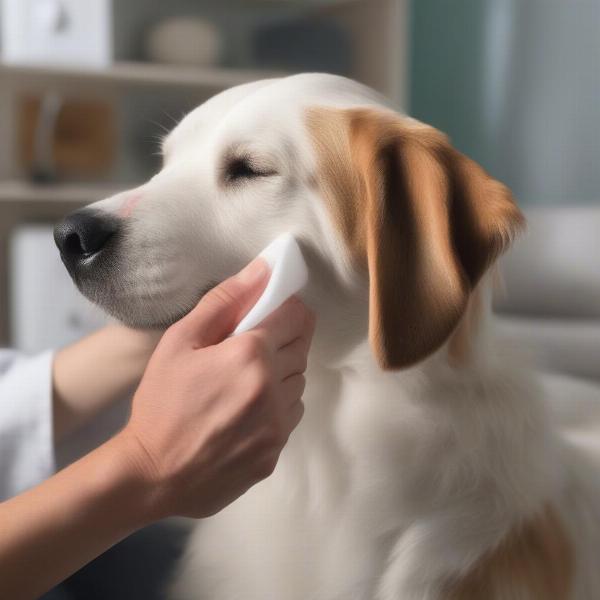Bleeding from a dog’s ear can be alarming, but it’s essential to stay calm and assess the situation. Understanding the potential causes and knowing how to effectively stop the bleeding can help prevent further complications and ensure your furry friend’s well-being. This guide provides practical, step-by-step advice on how to manage a bleeding dog ear, from initial first aid to when veterinary care is necessary.
Identifying the Cause of Bleeding
Before attempting to stop the bleeding, try to identify the source. Common causes of ear bleeding in dogs include:
- Ear infections: Infections can cause inflammation and rupture of blood vessels within the ear canal.
- Ear mites: These tiny parasites can cause intense itching, leading to scratching and potential bleeding.
- Foreign objects: Grass seeds, thorns, or other objects lodged in the ear can irritate and damage the delicate skin.
- Trauma: A bite wound, scratch, or impact to the head can cause ear injuries and bleeding.
- Aural hematoma: This is a pocket of blood that forms between the cartilage and skin of the ear flap, often caused by head shaking or scratching.
- Ear tumors: Although less common, tumors in the ear canal can sometimes bleed.
First Aid for a Bleeding Dog Ear
If your dog’s ear is bleeding, follow these steps:
- Stay Calm: Your dog can sense your anxiety, so it’s crucial to remain calm and reassuring.
- Restrain Your Dog: Gently but firmly restrain your dog to prevent further injury and allow you to examine the ear.
- Apply Direct Pressure: Using a clean gauze pad or cloth, apply gentle, direct pressure to the bleeding area. Hold the pressure for several minutes to encourage clotting.
- Keep the Area Clean: Avoid using cotton swabs or other objects to clean the ear as this could worsen the injury.
- Elevate the Head: If possible, gently elevate your dog’s head to help reduce blood flow to the ear.
 Applying first aid to a bleeding dog's ear
Applying first aid to a bleeding dog's ear
When to Seek Veterinary Care
While minor bleeding may stop with first aid, it’s crucial to seek veterinary care if:
- The bleeding is heavy or doesn’t stop after 10-15 minutes of direct pressure.
- Your dog is in significant pain.
- You suspect a foreign object is lodged in the ear.
- The ear appears severely damaged or deformed.
- Your dog exhibits signs of infection, such as swelling, redness, or discharge.
“Any bleeding that doesn’t stop quickly or is accompanied by other symptoms warrants a visit to the veterinarian,” advises Dr. Emily Carter, a veterinary dermatologist with over 15 years of experience. “Early diagnosis and treatment are key to preventing complications and ensuring a full recovery.”
Preventing Future Ear Bleeding
Taking preventative measures can minimize the risk of future ear bleeding. This includes:
- Regular Ear Cleaning: Cleaning your dog’s ears regularly can help prevent infections and remove debris that could cause irritation.
- Parasite Control: Use preventative medications to protect your dog from ear mites and other parasites.
- Careful Grooming: Trim the hair around the ears to improve air circulation and reduce the risk of matting and infection.
- Addressing Underlying Health Issues: If your dog has allergies or other underlying health conditions that contribute to ear problems, work with your veterinarian to manage them effectively.
Long-Term Care and Management
After the bleeding has stopped and the underlying cause has been addressed, follow your veterinarian’s instructions for aftercare. This may include:
- Administering medications, such as antibiotics or anti-inflammatory drugs.
- Using ear drops or ointments.
- Keeping the ear clean and dry.
- Preventing your dog from scratching or shaking its head excessively.
“Consistent aftercare is essential for preventing recurrence and ensuring complete healing,” adds Dr. Carter. “Follow your veterinarian’s recommendations closely and don’t hesitate to ask any questions.”
Conclusion
Knowing how to stop a dog’s ear from bleeding is a valuable skill for any dog owner. By following the steps outlined in this guide and seeking veterinary care when necessary, you can help ensure your furry friend’s health and well-being. Remember, early intervention is key to preventing complications and promoting a speedy recovery.
FAQ
- What should I do if my dog’s ear starts bleeding profusely? Apply direct pressure and immediately seek veterinary attention.
- Can I use hydrogen peroxide to clean my dog’s bleeding ear? No, hydrogen peroxide can further irritate the injured tissue. Use only veterinarian-approved cleaning solutions.
- How can I prevent my dog from scratching its ears? An Elizabethan collar can help prevent scratching.
- Are certain breeds more prone to ear bleeding? Dogs with floppy ears or excessive ear hair may be more susceptible to ear infections and subsequent bleeding.
- What is the cost of treating a bleeding dog ear? The cost varies depending on the underlying cause and the required treatment.
Related Articles
ILM Dog is your trusted resource for expert dog care advice. We offer comprehensive information on dog breeds, health, training, nutrition, grooming, and much more. Our team of experts is dedicated to providing practical and reliable guidance to help you provide the best possible care for your canine companion. For expert advice on dog health and care, contact us at [email protected] or call us at +44 20-3965-8624. Visit ILM Dog for more helpful resources.